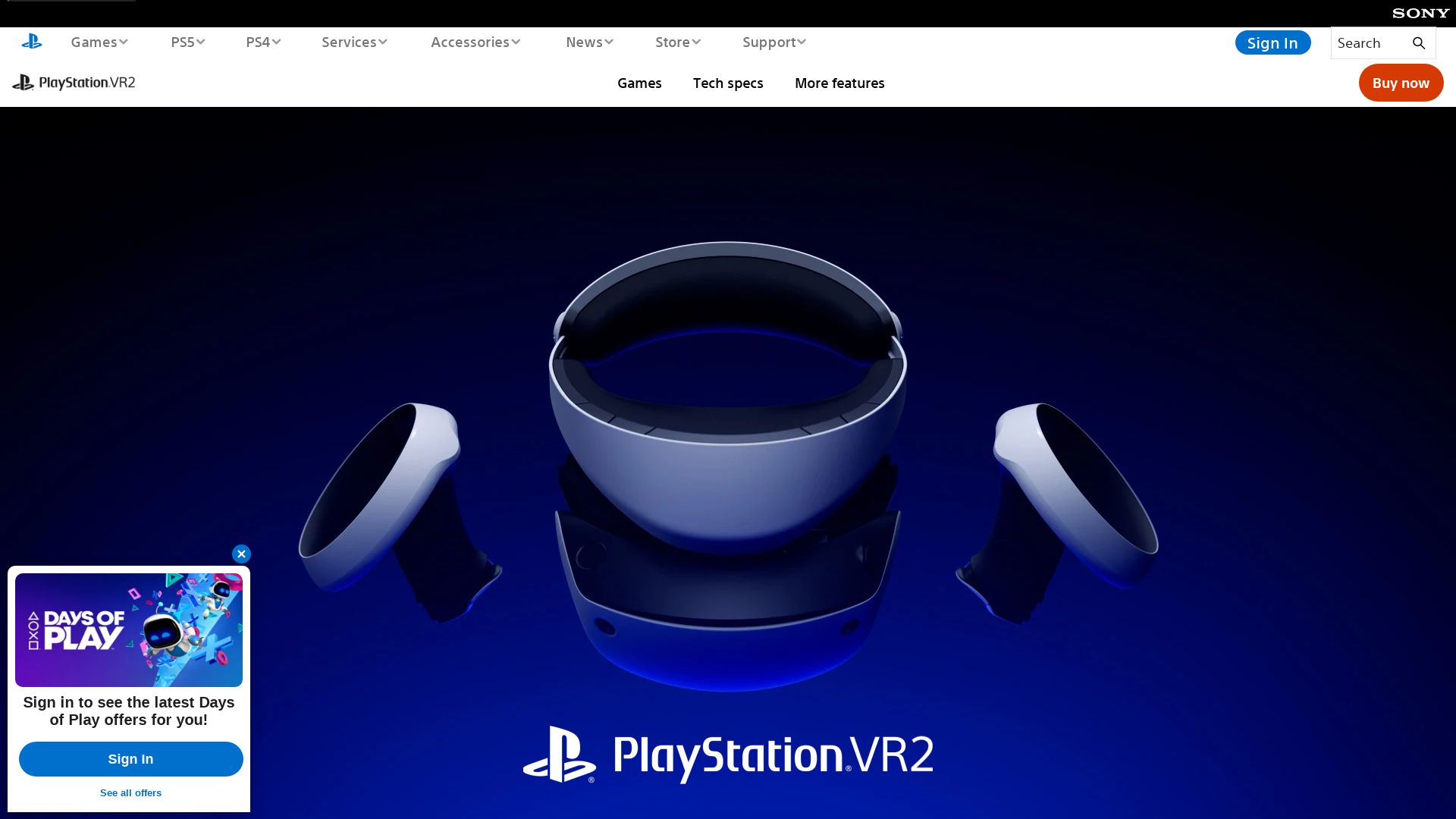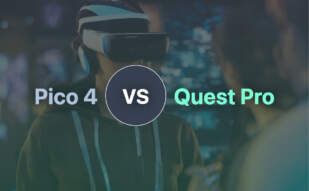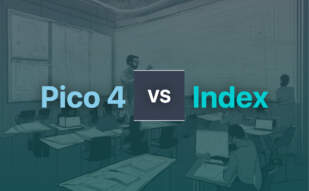Pico 4 Enterprise elevates VR experiences for businesses, featuring a 4K display, Snapdragon XR2 chip for seamless performance, and numerous productivity-boosting features.

Looking for options beyond Pico 4 Enterprise? Explore Pico 4, Pico 4 Pro, Rift S, Quest Pro, Quest 3, Quest 2, Index, Valve Index, Reverb G2, PSVR 2, and more in the VR landscape.
Pico 4
Introduced by ByteDance, the Pico 4, along with its business-savvy counterpart, the Pico 4 Enterprise, are VR headsets designed to offer immersive experiences supported by ergonomic comfort. Through a combination of sophisticated hardware, rich features, and a balanced design, Pico 4 brings the virtual reality experience into small but impactful dimensions.
Pico 4 Top Features
- Optimized design: Light and compact, with a weight of just 295g (excluding strap).
- Advanced hardware: Powered by Qualcomm Snapdragon XR2 with 8GB LPDDR4 RAM.
- Outstanding display: Boasts 2 Fast-LCD displays with over 2K resolution per eye.
- Pico OS 5.0: Runs on Pico’s latest operating system.
- Technical upgrades: Pico 4 Enterprise version sports LPDDR5 RAM, better catering to business needs.
| Feature | Benefit |
|---|---|
| Automatic interpupillary distance adjustment: | Comfortable for a range of users without manual adjustments. |
| Pancake lenses: | Contributes to weight reduction and improved image quality. |
| SLAM omnidirectional positioning: | Enhances tracking and positioning for controller and headset. |
Pico 4 Limitations
- Reduced field of view: The compact Pancake lenses result in a smaller field of view.
- Limited game library: Critiqued for its limited selection of games.
Pico 4 Pricing
The Pico 4 is available for purchase at €429 on platforms such as Amazon and XRshop.
Pico 4 Use Cases
Use case 1
Pico 4 offers immersive VR experiences ideal for gaming environments, striking the optimal balance between display quality and system performance.
Use case 2
Pico 4 can be used for business-focused applications, particularly the Pico 4 enterprise variant, which offers enhanced system RAM.
Use case 3
Thanks to its ergonomic design, the Pico 4 can support long VR sessions, making it ideal for virtual tours or extended training sessions.
Pico 4 Pro
In the sphere of Virtual Reality headsets, Pico 4 Pro emerges as a conciliatory contender, notably catering to the enterprise market. A riveting innovation by ByteDance, presently known for its acquisition of Pico’s legacy, it introduces its maiden consumer VR venture with the Pico Neo 3 Link.
Pico 4 Pro Top Features
- Qualcomm’s Snapdragon XR2 processor, ensuring powerful, seamless performance.
- Compact and sleek design with reduced bulk, courtesy of ‘pancake optics’.
- Superior per-eye resolution of 2,160 × 2,160 (4.7MP), outshining Meta’s Quest 2.
- Backward compatibility with Pico 3 and Pico 3 Pro applications, ensuring adaptability and connectivity.
- Eye and face-tracking capabilities enhancing user interaction with virtual environments.
| Feature | Benefit |
|---|---|
| 8GB LPDDR5 memory | For dynamic, uninterrupted VR experience. |
| Rear-mounted battery | Offers improved balance and weight distribution for effortless use. |
| Custom enterprise-targeted features | Includes device management software and tailored custom app stores to cater to business needs. |
Pico 4 Pro Limitations
- Lack of explicit design for mixed or augmented reality use.
- No immediate hand-tracking functionality.
- Software compatibility primarily with Quest 2, running the same OS with limited Quest 3-optimized titles, thus restricting its reach in a diversified VR marketplace.
Pico 4 Pro Pricing
The elegant Pico 4 Pro commences at a palatable €430 for the 128GB model, with the 256GB variant available at €500, subtly undercutting Meta’s Quest 2 in the pricing race.
Pico 4 Pro Use Cases
Use case 1
The Pico 4 Pro, with its superior eye-tracking and face-tracking features, showcases immense potential for application in professional training and simulation environments.
Use case 2
Thanks to its high-resolution output, the Pico 4 Pro serves as an ideal tool for immersive design and architectural visualization, offering a novel perspective for professionals in these fields.
Use case 3
With its powerful Snapdragon XR2 processor and 8GB memory, the Pico 4 Pro provides a robust platform for developers to create dynamic VR gaming experiences.
Rift S
Introducing the Rift S, an impressive VR system developed by Facebook Technologies and Lenovo, launched in March 2019 as a successor to the original Oculus Rift.
Rift S Top Features
- Improved “inside-out” positional tracking system utilising Oculus Insight tech.
- High-resolution display of 2560×1440 resulting in enhanced image clarity.
- Five built-in cameras (2 front, 1 top, 2 sides) for precise room-scale tracking.
- Next-generation lens technology to obliterate god rays and a dazzling field of view of 115°.
- Features a Passthrough+ safety feature prompting monochrome surroundings upon exiting designated boundaries.
- Comfortable Lenovo-designed halo headband for effective weight distribution.
- Pair of redesigned Oculus touch controllers optimised for inside-out tracking.
| Feature | Description |
|---|---|
| Connection | You get a 5m tether cable (DisplayPort 1.2, USB 3.0). |
| Display | Fast-switch LCD panel tech for smooth interactions and sharper visuals. |
| Audio | Integrated speakers and a 3.5mm stereo headphone jack for immersive sound. |
Rift S Limitations
- Received mixed reviews as only an incremental upgrade over the original model.
- Adjustable IPD solely via software as it employs a single screen.
- Rift S is no longer in production as of June 2021; availability may vary.
Rift S Pricing
The Rift S comes with a substantial price tag of $399 that reflects its wealth of high-performance features.
Rift S Use Cases
Use Case 1
For passionate gamers, the Rift S offers immersive gaming experiences achieved via its advanced tracking cameras and high-resolution display.
Use Case 2
For the tech-savvy, the Rift S with its Oculus Insight tracking tech and next-generation lens technology, serves as a premium device to experience top-notch VR content.
Use Case 3
For VR developers, the Rift S provides a robust platform for developing and fine-tuning VR games and experiences.
Quest Pro
Quest Pro is a state-of-the-art VR/AR headset powered by Snapdragon XR2+ designed specifically for enterprise users. It offers an unparalleled blend of performance, design, and mixed reality capabilities.
Quest Pro Top Features
- Design: sleek, black, professional-looking with a glossy front panel.
- Powerful Processor: Snapdragon XR2+, 50% stronger than Quest 2.
- High Resolution: 1,920 x 1,800 pixels per eye, 130% larger color gamut than Quest 2.
| Storage | Extended 256GB for larger projects |
| Comfort | Wraparound band with padding, optional full light blocker accessory |
| Battery Life | Expedited charging with two included sets, charging via cradle. |
Quest Pro Limitations
- More expensive compared with Meta Quest 2 and 3.
- Headset may press against face, potentially interrupting peripheral vision.
- Limited consumer-focused software leveraging Quest Pro upgrades.
Quest Pro Pricing
With a price tag of $1499.99, Quest Pro is three times the price of Meta Quest 2, making it an ideal investment for professionals needing specific VR/AR solutions.
Quest Pro Use Cases
Use Case 1: Workflow Integration
With features like Meta Horizon Worlds and custom interfaces for collaborative work, it’s ideal for efficient team-based projects.
Use Case 2: Gaming Development
With its superior graphic performance, Quest Pro is an optimal tool for game developers with mature-rated apps available.
Use Case 3: Immersive Learning
The enhanced resolution and color gamut offers an immersive experience, making it suitable for educational and training purposes.
Quest 3
Introducing the Meta Quest 3, the world’s first mass-market mixed reality headset, boasting improved performance, increased resolution, and enhanced mixed reality capabilities.
Quest 3 Top Features
- 30% increase in visual resolution compared to its predecessor, the Meta Quest 2, delivering an immersive and top-notch user experience.
- Powered by the Qualcomm Snapdragon XR2 Gen 2 platform, offering double the graphic processing power of Quest 2.
- Features a 4K+ Infinite Display offering 25 pixels per degree, and a staggering 1,218 pixels per inch.
- Equipped with comfortable “pancake” lenses and redesigned adjustable strap for comfort and customization.
- Improved pass-through cameras and a new depth sensor for an automatic guardian system to prevent collisions and create new spatial data.
| Software Compatibility | Backwards compatible with Quest 2 titles plus 100 new and updated coming titles. |
| Sound Quality | Enhanced sound clarity and bass performance with a 40% louder audio range than Quest 2. |
| PC VR Streaming | Supports PC VR streaming for a more versatile gaming experience. |
Quest 3 Disadvantages
- May be out of budget for some, with prices starting from $499.99.
- Despite the new design, some may still find extended usage uncomfortable.
Quest 3 Pricing
Two models are available for purchase, the 128GB priced at $499.99 and the 512GB priced at $649.99.
Quest 3 Use Cases
Use Case 1: Augmented Reality Gaming
The Meta Quest 3 brings gaming to life, with applications such as Demeo using the headset’s capabilities to overlay virtual elements onto your physical environment, creating an immersive gaming experience.
Use Case 2: Fitness Training
The enhanced resolution and sound quality of the Meta Quest 3 provide a more immersive fitness training experience with apps like Xponential+.
Use Case 3: Sports Viewing
The high-quality visuals and powerful processors of the Meta Quest 3 bring sports-viewing experiences to a new level, especially when using apps like Xtadium.
Quest 2
Developed by Reality Labs, a division of Meta Platforms, the Quest 2 is a renowned VR headset that ushered in a new era for virtual reality experiences. Originally known as Oculus Quest 2, the headset was rebranded as Meta Quest 2 in 2022 as part of Meta’s transition, pushing the boundaries of immersive VR technology.
Quest 2 Top Features
- Powered by Qualcomm’s potent SnapDragon XR2 processor coupled with 6 GB LPDDR4X RAM for high-speed performance.
- Offers 1832 x 1920 RGB LCD resolution per eye, providing a vivid virtual environment with refresh rates ranging from 72 to 120 Hz.
- Functionality refined with a lighter weight and long-lasting Oculus Touch controllers that offer superior precision.
- 6DOF inside-out tracking completed through four integrated cameras and two adept controllers.
- Equipped with USB-C, Bluetooth 5, and Wi-Fi 6 for seamless connectivity.
- A comprehensive VR content catalog with Meta’s Quest Store.
| Feature | Details |
|---|---|
| Weight | 503g- a significant reduction rendering it easier to wear. |
| Storage Variant | 64 GB (discontinued), updated storage options include 128GB and 256GB. |
| Stand-alone Operation | Operates independently with internal OS or runs desktop-based Oculus Rift-compatible VR software. |
Quest 2 Downsides
- Persistent short battery life, only lasting between 2-3 hours per charge-cycle.
- Original 64GB storage variant discontinued and new versions don’t provide room for expansion.
- The requirement of a Meta account for users aged 10+ on Quest 2 and 3.
Quest 2 Pricing
The Quest 2 offers two pricing variants – $299 for the 64GB model, and $399 for the more spacious 256GB model.
Quest 2 Use Cases
User Case 1
For game developers, Quest 2 is instrumental in creating immersive gaming environments with its high-resolution display and potent performance capabilities.
User Case 2
Enterprises leveraging VR technology for training or simulation scenarios can benefit from the high refresh rates and accurate tracking system of the Quest 2.
User Case 3
Enthusiastic VR gamers can exploit the vast game library available at the Quest Store for an unparalleled gaming experience.
Index
The tech world is in awe of Index, the revolutionary tool that sheds light over programming language trends. Taking center stage in October 2023, it highlighted the spectacular chase between c# and Java in the realm of programming languages.
The Wonders of Index
- A storehouse of trends in programming languages, with data supporting C#’s rise, and Java’s decline.
- Seismic shift witnessed by Index: Oracle’s Java 8 license induced drop countered by C#’s free, open-source spirit.
| Course Module Highlights | Google Search Operation |
|---|---|
| JavaScript, CSS, HTML fundamentals, keyboard events & more! | Crawling, Indexing, Serving search results |
| Interactive quizzes and real-world assignments | Canonical pages & Clustering for improved search results |
The Chinks in Index’s Armor
- Indexing issues may arise due to low-quality content, robot meta rules, and website design hitches.
Index – A Free Tool!
In the world of data, here’s the shocker – Index is free, dissecting the tech world without asking for a penny!
Index Use Cases
Use Case 1: Burgeoning Developers
For those tiptoeing in the tech sphere, Index is your guiding star, helping you make informed decisions about which programming language to get snug with. Love a good underdog story? C#’s emergence might just inspire your coding journey!
Use Case 2: Tech Organizations
Why be blindsided in this rapidly evolving tech era? Tech companies, arm yourself with Index to understand shifts in programming dynamics, and strategize accordingly.
Use Case 3: Academic Institutions
Academic institutions, fuel your curriculums with Index’s rich data. Foster a generation of programmers versed in the most relevant and trending languages.
Valve Index

Delve into the immersive realm of augmented gaming with the Valve Index, a visionary product brought forth by Valve. This pioneering virtual reality headset, entering the scene in June 2019, boasts heightened capabilities that aid in creating richer and more intricate gameplay experiences.
Valve Index Best Features
- The vibrant visuals powered by dual 1440 x 1600 RGB LCDs with 50% increased subpixels than OLED for enhanced sharpness.
- Astonishing variable frame rates (80/90/120/144Hz) for maximum optical comfort during lengthy sessions.
- An expanded Field of View (FOV), deviating 20 degrees beyond that of HTC Vive due to finely-calibrated lenses.
- Unique off-ear audio solution for comfort, equipped with adjustable speakers that cater well to a variety of ear/head shapes.
- Systems compatibility with Windows and Linux, maintaining an agnostic stance toward hardware.
- Impeccable tracking system featuring SteamVR 2.0 sensors, remaining compatible with HTC Vive and Vive Pro Controllers.
| Engine | Details |
|---|---|
| Connections | 5m tether, 1m breakaway trident connector. adopting USB 3.0, DisplayPort 1.2, 12V power. |
| Controllers | Armed with 87 sensors to map out hand and finger positions; inclusive of a joystick, touchpad, two face buttons, a menu button, and a trigger. |
| Front Expansion Slot | Crafted with a USB 3 Type-A port, allowing custom additions to escalate the gaming experience. |
Valve Index Limitations
- Noteworthy hefty price tag, requiring a considerable investment.
- Lack of eye tracking technology and tactile feedback, curtailing the spectrum of interaction within the gaming universe.
- Relatively low supply during launch period, amplified by COVID-19 consequences.
- Potentially redundant controller setup for certain games, influencing its universal applicability.
Valve Index Pricing
The initial pricing of the headset alone stood at $999, slightly easing now to $799. For the full assembly inclusive of all the engineered features, the cost hovers around $999.
Valve Index Use Cases
Use case 1
Illustrating the expressive potential of VR, the Valve Index makes a worthy companion for professional game developers looking to weave intricate storylines and multi-dimensional characters within their virtual worlds.
Use case 2
Educators and trainers seeking to transport their pupils into fully immersive learning environments can harness the high fidelity visuals and audio features of Valve Index.
Use case 3
Experimental artists and designers aiming to craft immersive narratives can certainly benefit from the Valve Index’s comprehensive feature set that allows transformative storytelling capabilities.
Reverb G2
Emerging from the tech forge of HP, Reverb G2 is their spin-throw at the VR arena. Pouring PC power into a consumer headset and built for the Windows Mixed Reality platform, it’s a carefully balanced juxtaposition of price and performance.
Reverb G2 Top Features
- Enhanced motion tracking and comfort aimed at refining your immersive experience.
- Facemask that’s filled with memory foam, ensuring unmatched comfort, backed by being washable.
- External cameras for motion tracking, killing the need for traditional sensors or beacons.
- Offers DisplayPort-to-mini-DisplayPort and USB-C-to-USB-A adapters.
- Flaunts dual 2160 by 2160 screens at 90Hz, rendering a crisp picture quality.
- Works like a charm with both SteamVR and Windows Mixed Reality, garnished with an easy setup process.
| Perks | Drawbacks |
|---|---|
| Sharper than Valve Index | Lower resolution than Oculus Quest 2 |
| Better than HTC Vive Cosmos | Occasional tracking hiccups |
Reverb G2 Downsides
- Intermittent hiccups in camera-based motion tracking, affecting controller movements.
- Occasional struggles in keeping track of controller movements.
- May entail run-ins with the interface on Windows Mixed Reality platform.
- Demands a powerful PC, making it a bit of a high-roller’s toy.
Reverb G2 Pricing
With a price tag of $599.99, Reverb G2 settles comfortably in the sweet spot between Valve Index ($999) and HTC Vive Pro 2 ($799) above, and standalone Oculus Quest 2 ($299.99) below it.
Reverb G2 Use Cases
Game Developers
Boasting compatibility with the likes of Project CARS Pagani Edition, Aim Lab VR, Nvidia VR Funhouse, and VRChat, Reverb G2 opens up a broad canvas for game developers.
AR Enthusiasts
Its high-quality visuals backed by an easy setup process positions Reverb G2 as a go-to choice for AR enthusiasts looking to tip their toes into the streams of immersion.
Educators and Trainers
Reverb G2’s potential extends well beyond gaming. The precise motion tracking and comfort make it a viable tool for educators and trainers for simulated learning experiences.
PSVR 2

Immerse yourself in a whole new reality with the groundbreaking PSVR 2. It’s a sophisticated hardware upgrade from its predecessor, finding its rightful home with the PlayStation 5. A marvel of innovation, it delivers an enhanced VR experience, albeit with several constraints.
Top Features of PSVR 2
- High Resolution: Upgraded from the original 960 x 1,080 pixels to an incredible 2,000 x 2,040 pixels per eye, for enhanced visual precision.
- Comfort Design: With an adjustable lens and sturdy headband, the PSVR 2 ensures maximum comfort for extended periods of usage.
- Inside-Out Tracking & Eye-Tracking: Optimize your VR experience with position tracking and eye movement detection.
- Advanced Controllers: The updated Sense Controllers offer refined navigation and interaction in the VR environment.
- Haptic Feedback: With headset feedback and adaptive triggers, you can truly feel every in-game interaction, increasing game immersion.
| Specs | Details |
|---|---|
| Field of View | Approx. 110 Degrees |
| Refresh Rate | Up to 120Hz |
| Connection | Single USB-C input for ease of setup |
PSVR 2 Limitations
- Hardware Prerequisite: Requires PlayStation 5 for operation, increasing the total cost.
- Battery Life: Controllers drain quickly, requiring frequent recharging.
- Compatibility Issues: Not backward-compatible with PSVR 1 games, and locked out of PC use.
- Game Library: Has exclusive VR titles, but the pool is considerably smaller than rival platforms like Steam or Meta.
PSVR 2 Pricing
The PSVR 2 can be a dent to your wallet with a price tag of $549.99/£529.99, and that’s not considering the additional cost of necessary accessories and, crucially, the PlayStation 5 console itself.
PSVR 2 Use Cases
Entertainment
Make the most of your PlayStation 5 with the PSVR 2, whether it’s immersing yourself in an exclusive VR title or exploring new dimensions in gaming.
Virtual Tourism
With its high-resolution display and comfort-focused design, traversing digital landscapes can feel alarmingly real, making virtual tourism an intriguing prospect.
Professional Training
From flight to medical simulations, PSVR 2’s precise tracking and realistic feedback pave the way for high-quality professional training experiences.
Patrick Daugherty
Content writer @ Aircada. Merging AR expertise with a love for late-night gaming sessions.





